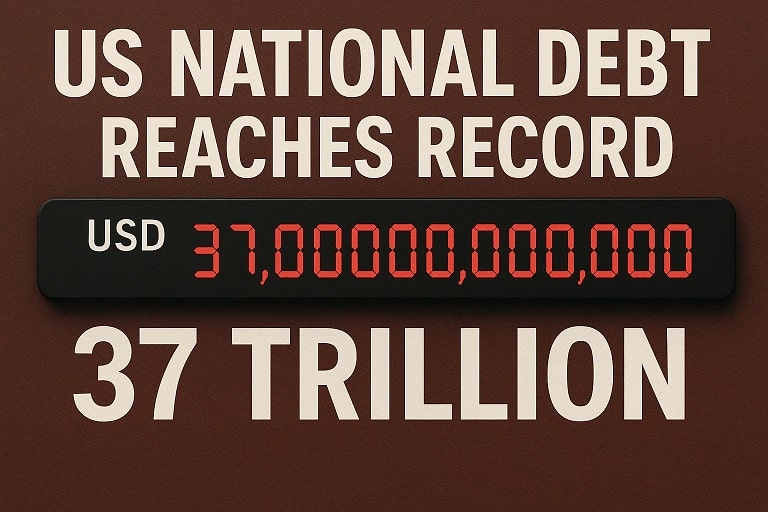U.S. National Debt Hits Record $37 Trillion, Raising Alarms Over Economic Future
Washington, DC, August 13, 2025 – The U.S. national debt has soared past a historic $37 trillion, according to a Treasury Department report released on August 12, 2025, marking a record-breaking milestone that underscores the accelerating fiscal burden on America’s economy. Reached years ahead of pre-pandemic projections, this figure—equating to $37,004,817,625,842.56 as of Tuesday afternoon—has ignited urgent calls for action amid fears of rising interest costs, inflation, and long-term economic instability. The rapid debt accumulation, fueled by pandemic-era borrowing and recent tax cuts, poses a “slow burn” threat to taxpayers and the broader economy.
A Milestone Ahead of Schedule
The Treasury’s latest daily financial report confirms the gross national debt crossed $37 trillion, a threshold the Congressional Budget Office (CBO) in January 2020 projected would not be reached until after fiscal year 2030. The debt’s rapid climb—hitting $34 trillion in January 2024, $35 trillion in July 2024, and $36 trillion in November 2024—reflects an unprecedented pace, with an additional $1 trillion added roughly every five months, more than twice the average rate over the past 25 years.
This acceleration stems largely from massive borrowing during the COVID-19 pandemic under Presidents Donald Trump and Joe Biden, which stabilized the economy amid shutdowns but ballooned deficits. The Trump administration’s recent “One Big Beautiful Bill,” signed into law on July 4, 2025, adds $4.1 trillion to the debt over the next decade through tax cuts and increased spending on defense and border enforcement, according to CBO estimates. These policies, combined with rising interest payments—now nearly $1 trillion annually—have pushed the debt to surpass the combined GDP of the Eurozone and China.
Economic Impacts: A Growing Burden
The $37 trillion debt, equivalent to 124% of U.S. GDP, imposes significant costs on taxpayers and the economy. Interest payments alone consume over 25% of federal revenue, exceeding spending on national defense or Medicare. Michael Peterson, CEO of the Peter G. Peterson Foundation, warned that this “crowds out important priorities, creating a damaging cycle of more borrowing, more interest, and even more borrowing.” The Joint Economic Committee projects the debt could reach $38 trillion in just 173 days at the current growth rate.
Rising debt fuels inflationary pressures, pushing up interest rates and borrowing costs for households. The Government Accountability Office notes that Americans face higher mortgage and auto loan rates, lower wages due to reduced business investment, and pricier goods and services. Wendy Edelberg of the Brookings Institution highlighted the trajectory, stating, “We’re going to borrow a lot over 2026, a lot over 2027, and it’s just going to keep going,” driven by Congress’s spending and revenue policies.
Policy and Political Reactions
The milestone has sparked bipartisan concern, though solutions remain divisive. Budget Committee Chairman Jodey Arrington (R-Texas) called the debt a “stark reminder of our dire fiscal straits,” noting that interest costs now rival major federal programs. He pointed to Republican efforts in the recent tax bill to curb mandatory spending, alongside President Trump’s reciprocal trade policies yielding record tariff revenue, as steps toward fiscal discipline. However, critics argue these measures fall short, with the CBO projecting a $150 trillion debt by 2055 if trends persist.
Maya MacGuineas, president of the Committee for a Responsible Federal Budget, urged swift action, stating, “Hopefully this milestone is enough to wake up policymakers to the reality that we need to do something, and we need to do it quickly.” On the Democratic side, calls for balanced approaches—combining spending cuts with targeted tax increases—face resistance from Republicans prioritizing tax reductions.
Public sentiment on X reflects alarm and division. @WallStreetMav noted, “We’re paying $1.3 trillion in interest alone—25% of all government revenue,” while @AmericaPartyX warned, “The collapse gets closer every day.” Conversely, @shellenberger argued that tariffs could fund debt reduction, though most economists dispute this, citing their inflationary impact.
Broader Context: Global and Domestic Pressures
The debt surge coincides with U.S. efforts to maintain global economic leadership amid challenges like Trump’s tariffs, which raised the effective rate to 18.3% in 2025, contributing to a projected GDP slowdown to 1.5%. These tariffs, alongside calls to curb Indian tech hiring, strain relations with allies like India, a key smartphone supplier and security partner. Meanwhile, India’s space achievements, such as the NISAR satellite launch, highlight its growing role in U.S. strategic priorities, complicating trade tensions.
Domestically, the debt burden exacerbates economic uncertainty. The July 2025 jobs report showed only 73,000 jobs added, with manufacturing and retail sectors hit hard by tariff-related disruptions. Consumer spending, a key GDP driver, fell $29 billion in May, reflecting caution amid rising costs. The Federal Reserve, grappling with 2.8% inflation, faces a delicate balance, with rate hikes risking further slowdown and cuts potentially fueling price increases.
Path Forward: Challenges and Solutions
Addressing the debt requires tough choices. Proposed solutions include reforming entitlement programs like Social Security and Medicare, which account for half of federal spending, or raising taxes, though both face political hurdles. Republicans advocate spending cuts and growth-driven policies, while Democrats push for progressive taxation. The Penn Wharton Budget Model warns that inaction could lead to a 6% GDP drop and a $22,000 lifetime loss per middle-income household.
Optimists point to potential revenue from tariffs and economic growth, with the S&P 500 up 25% since April 2025. However, economists like Mark Zandi of Moody’s Analytics describe the debt as a “bright red flare” of economic harm, predicting a pronounced slowdown if unaddressed.
Conclusion: A Fiscal Tipping Point
The U.S. national debt’s climb to $37 trillion marks a critical juncture, threatening economic stability and global competitiveness. As interest costs soar and policy debates intensify, the nation faces a narrowing window to avert a fiscal crisis. Balancing growth, spending restraint, and revenue generation will test policymakers, with the stakes—higher costs, slower growth, and diminished priorities—affecting every American. As allies like India bolster U.S. supply chains and security, the debt’s shadow looms large, demanding action to secure the nation’s economic future.













